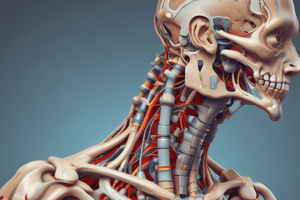Podcast
Questions and Answers
What are the three key components of the musculoskeletal system?
What are the three key components of the musculoskeletal system?
Muscles, Bones, Joints
What are the three types of muscles classified based on their structure and function?
What are the three types of muscles classified based on their structure and function?
Skeletal, Smooth, Cardiac
What are the primary components of each muscle that enable movement?
What are the primary components of each muscle that enable movement?
Actin, Myosin
What are the main functions of bones in the musculoskeletal system?
What are the main functions of bones in the musculoskeletal system?
Signup and view all the answers
What are the three types of bones in the human body?
What are the three types of bones in the human body?
Signup and view all the answers
What is the function of synovial fluid in synovial joints?
What is the function of synovial fluid in synovial joints?
Signup and view all the answers
How does the musculoskeletal system enable movement?
How does the musculoskeletal system enable movement?
Signup and view all the answers
What is the primary function of myosin in muscle contraction?
What is the primary function of myosin in muscle contraction?
Signup and view all the answers
What is the role of bones in the human body?
What is the role of bones in the human body?
Signup and view all the answers
What are the primary types of joints in the human body?
What are the primary types of joints in the human body?
Signup and view all the answers
Study Notes
Exploring the Musculoskeletal System: Anatomy, Muscles, Bones, Joints, and Movement
The musculoskeletal system is a complex and intricate arrangement of muscles, bones, and joints that work in unison to enable movement, support, and stability. In this article, we'll delve into the fascinating world of the musculoskeletal system, covering its anatomy, the importance of muscles, the role of bones, how joints enable movement, and the interplay between these components.
Anatomy
The musculoskeletal system is composed of three key components:
- Muscles: These are the body's contractile tissues that enable movement and maintain posture. Muscles are classified into three types: skeletal (striated and multinucleated), smooth (found in the walls of internal organs), and cardiac (present only in the heart).
- Bones: Bones provide structural support, protect vital organs, and facilitate the attachment of muscles and other soft tissues. Bones are primarily made of collagen (fibrous proteins) and minerals.
- Joints: Joints are the points at which bones meet, allowing for movement and stability. There are six main types of joints: fibrous, cartilaginous, synovial, and so on.
Muscles
Muscles are the primary movers of the human body. They contract (shorten) and relax (lengthen) to produce movement. Each muscle has two primary components:
- Actin: Thin, elastic filaments that slide past myosin during muscle contraction.
- Myosin: Thick, contractile filaments that move actin filaments, causing muscle contraction.
Muscles are arranged in groups called muscle fascicles, which are organized into muscle bundles and ultimately form the entire muscle.
Bones
Bones serve as the body's structural foundation and provide a framework for the attachment of muscles and other tissues. Bones also store important minerals like calcium, phosphorus, and fluoride. There are three types of bones:
- Long bones: These bones are longer than they are wide, such as the femur (thigh bone) and humerus (arm bone).
- Short bones: Short bones are roughly cube-shaped, like the carpals (wrist bones) and tarsals (ankle bones).
- Flat bones: Flat bones, such as the skull bones and ribs, provide protection and serve as attachment sites for muscles.
Joints
Joints are the points where bones meet, allowing for movement and stability. The primary types of joints are:
- Fibrous joints: These joints lack a joint cavity and contain no synovial membrane, allowing for limited movement. Examples include the sutures in the skull and the joints between the bones of the spine.
- Cartilaginous joints: These joints contain cartilage, which provides support and cushioning. Examples include the joints between the vertebrae (intervertebral discs) and the joints between the ribs and the sternum.
- Synovial joints: These joints contain a joint cavity, synovial membrane, and synovial fluid, which lubricates and nourishes the joint. Synovial joints allow for a wide range of motion, such as the elbow, knee, and shoulder joints.
Movement
The musculoskeletal system enables movement by coordinating muscle contraction and relaxation with joint movement. The body's movements are initiated by the brain, which sends signals to motor neurons, which then transmit the signals to the muscles. When muscles contract, they pull on the bones, causing joints to move. The body's movements are complex, requiring a delicate balance between muscle activity and joint support.
In summary, the musculoskeletal system is a sophisticated and interconnected network of muscles, bones, and joints that work together to enable movement, support, and stability. Understanding the anatomy, function, and interaction of these components is essential for a comprehensive knowledge of the human body.
Studying That Suits You
Use AI to generate personalized quizzes and flashcards to suit your learning preferences.
Description
Test your knowledge of the musculoskeletal system, including its anatomy, the roles of muscles and bones, the types of joints, and how movement is enabled. Explore the intricate network of muscles, bones, and joints that work together to support the human body and facilitate movement.




